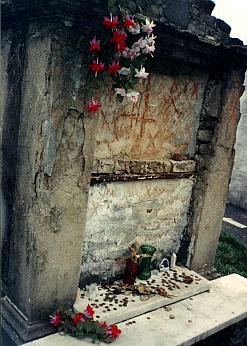1. She practiced New Orleans Voodoo, but was a lifelong devout Catholic. She was baptized, married and had her children baptized in St. Louis Cathedral. After she abdicated her “throne” as Voodoo Queen later in life, she dedicated herself to such philanthropic endeavors as feeding and comforting condemned prisoners who were headed for the gallows.
2. Many sources link her with another legendary New Orleans figure, Pere Antoine.Some say he officiated her wedding and baptized at least some of her children. Some say they actually worked together, caring for victims of yellow fever.
3. Depending on the source, she was either a rival of or apprentice to a Voodoo priest named Doctor John. Guess whose stage name was inspired by him? Yep, ol’ Mack Rebennack, who wrote this groovy song about her.
4. Strangely enough, Shel Silverstein – you know, the guy who wrote the kids’ books The Giving Tree and Where The Sidewalk Ends – wrote a song about Marie Laveau, performed by Dr. Hook. It’s not even remotely based on fact, but an amusing little ditty. (Shel also wrote “A Boy Named Sue” for Johnny Cash. Totally unrelated, but totally interesting, don’t you think?)
5. Most sources say her father, Charles Laveau, was a wealthy, white plantation owner. But there are those who suggest that her father was a free man of color, who spelled his surname, Laveaux. There’s even a government-issued historical plaque on a building in the Marigny that supports this theory.

Marie Laveau’s beauty and mystique are captured in many renderings, like this one by New Orleans artist, Dimitri Fouquet. (Image courtesy of nola.humidbeings.com)
6. After her first husband either died or disappeared, she had a white, common law husband, named Christophe Glapion, with whom she had as few as seven, or as many as 15 children. Apparently, as a free woman of color, she wasn’t legally allowed to marry a white man, but managed to live and procreate together.
7. She owned slaves! Wow, New Orleans had some really complicated social strata back then, and Marie Laveau was a prime example.
8. She was a highly sought-after hairdresserfor wealthy Creole and American women. Many say she gained power and prestige by becoming a confidante and sometimes Voodoo practitioner to these powerful citizens. Many also say blackmail may have played a role in her success.
9. Remember that scandalous 2009 incidentwhen reality show characters crashed a White House state dinner? Desiree Glapion Rogers, the first African-American White House social secretary and descendant of Marie Laveau, was at the center of that controversy. She stepped down soon thereafter, but became CEO of the publisher of Jet and Ebony magazines. Among her bragging rights is that she’s a two-time queen of the Krewe of Zulu.













